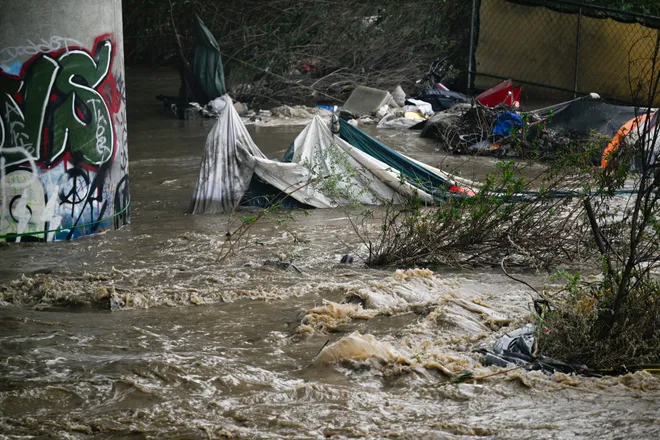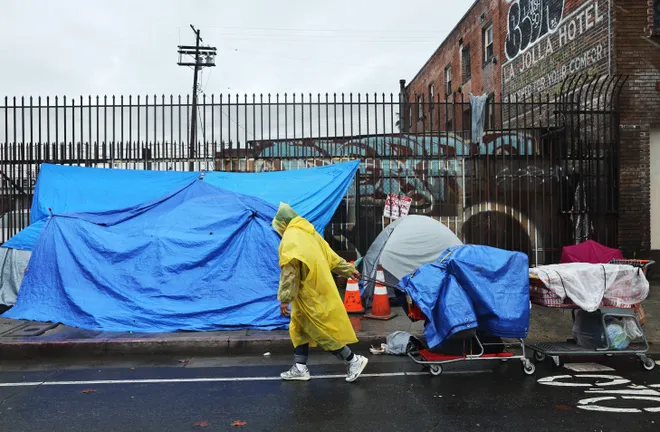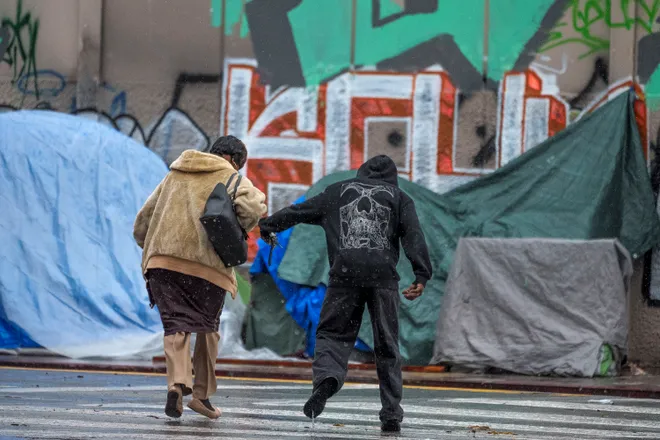California's big cities are usually dry. Floods make a homelessness crisis even worse.
SAN DIEGO – Record rains have soaked California's cities, exacerbating a homelessness crisis and endangering thousands of people who are living without consistent shelter.
Amid a deluge of rain on a Sunday night, staffers at Los Angeles' Midnight Mission homeless shelter opened their doors and dining room to more than 100 unhoused people living on Skid Row.
"People are freezing to their core, so being able to come in and sleep, get clean with showers and dry clothes is a big deal," said Georgia Berkovich, a spokesperson for Midnight Mission. "For people on the street, once your clothes are wet it’s over."
The Southern California deluge hits unhoused people particularly hard because the region doesn't usually get this drenched. New York gets more than 45 inches of rain a year on average while Chicago gets 36 inches.
In contrast, Los Angeles typically gets about 14 inches of rain a year and San Diego just over 10 inches. These historic storms dumped half of that amount, 7 inches, in just two days, February 4 and 5, according to the National Weather Service.
Because of that, homeless communities in cities like New York and Chicago have more experience – and infrastructure – to combat the deadly effects of storms. In Southern California, it's a different story.
The Midnight Mission shelter typically sees about 30 people on a normal night, Berkovich said. But the numbers increased more than three-fold as an unprecedented six inches of rain devastated encampments across the city.
The storm also brought hundreds of landslides and mudslides in California, leaving devastation for some of the more than 181,000 people experiencing homelessness across the state – especially for those living outdoors. Mayors from Los Angeles and San Diego both declared evacuation warnings for people living in low-lying and flood-prone areas.
The rains turned dry areas wet, trickles into streams and streams into torrents. Many unhoused people in Southern California find places to camp that are hidden away to avoid police sweeps, which can mean along riverbeds that are typically dry or shallow, under bridges and in tunnels – all areas that were swamped during the storms.
Service providers told USA TODAY that an influx of people need dry, clean clothes and a warm place for refuge. And even more people are displaced after the floods ruined their homes. Now, they're in desperate need of resources to help people facing life-or-death circumstances – and asking for help.
"We always need more," Berkovich said. "We need more ponchos, water, shelter, and hygiene kits. We're doing the best with the resources and staff we have."
This record-setting winter is particularly difficult for people who are unhoused in San Diego, said Father Joe's Village Deacon Jim Vargas. The organization helps people experiencing homelessness in San Diego with meals, shelter, ponchos and other resources they need year-round and during the storms.
"We're fortunate and blessed to be able to provide additional spots for people who need it," Vargas said. But even facilities used for sheltering people from the rain during the storm have incurred damage.
"A couple of weeks ago from today we were hit with extremely heavy rain and flooding," he said Monday. "A couple of our buildings were flooded, including our health center, which was very, very challenging."

Officials statewide also opened up additional resources to help unhoused residents cope with the dangerous conditions, including a winter shelter hosted by the Los Angeles Homeless Services Authority.
"We know the severe impact that weather can have on our communities, and we are making sure Los Angeles is prepared on behalf of our residents, including the unhoused Angelenos living on our streets, to get through this storm," said Los Angeles Mayor Karen Bass before the storm system hit Los Angeles.
Atmospheric river slams CaliforniaPrompting mudslide and flooding concerns: 'Do not let your guard down'
Encampments, shelters see devastation
In Los Angeles, unhoused people huddled under makeshift tarps and overhangs to escape the rain, photos in the Los Angeles Times show. On Wednesday a pregnant woman who had been living in a storm drain was rescued from a storm drain near Anaheim.
Many people lost their belongings, clothes and tents to the rain's damage, Berkovich said. And the sudden cold weather patterns can create fatal health risks for people who live outside.
Soaked clothing and bedding draws heat from the body rather than holding it in, putting those who live outside at risk.
"It's so strange. In LA we have this great climate, but people die of exposure to weather on our streets all the time," Berkovich added.
At least 14 people died from hypothermia on the streets of Los Angeles in 2021, The Guardian reported. And more unhoused people died from freezing temperatures in Los Angeles than in New York in 2019, the Los Angeles Times reported.
"And as it gets rainier, more people can develop hypothermia," Vargas said Monday.
Volunteers offer emotional support for flood victims
Rob and Amy Reardon saw the emotional toll that the flood took on unhoused people in San Diego firsthand. They've worked with the San Diego Regional Office of the Salvation Army for 26 years On Jan. 22 when torrential rains flooded city streets, Amy Reardon said that she had "a lot of people come in during the first week who just would sit down and start to cry."
Rob Reardon said apart from the pressing need for material help, mental health support for victims of the disaster was in huge demand.
“It's kind of like a triage counseling session,” he said of the response at the emergency centers.
The Jackie Robinson Family YMCA in Southeast San Diego also opened as a community support center in the wake of the flooding. Ariane Porras, the organization's community collaborative director, said the center first started offering hot showers in response to the crisis, but added more services over time, including an on-site mental health counselor.
"It's a lot of crisis processing," Porras said. "The concerns that they're having, these mental health crises, go anywhere from panic and shock to suicidal ideation."
"There's a lot of concern over safety and shelter and what's next," she added. "Like, what hope is there for their future?"
Both Reardons said they feared the flooding over the last few weeks would exacerbate the already dire need for more mental health support for San Diego’s unhoused population.
“We're all trying to do our part, but the resources are very slim, and in some places nonexistent,” Rob Reardon said. The flooding, he said, could “overwhelm the resources that are already in place.”
Porras echoed the pressing need for more resources, especially to treat those experiencing homelessness.
"We're trying to communicate to city officials, we've been doing this, but this is above our pay grade," she said. "We literally do not have the resources to continue to do these efforts that we've been doing since January 22. So, we need them to step in."
The San Diego Regional Office of the Salvation Army distributed more than $40,000 in financial assistance, clothing items, hygiene kits, and food to the more than 1,600 people who came to seek help, according to the organization.
“The reality is these floods took everything from people,” Reardon said. “There’s going to be a lot of grieving.”

Flood damage leaves more Californians displaced from their homes
The floods have displaced thousands of people from their homes, including 1,000 from the Jan. 22 storm in San Diego County, according to Voice of San Diego.
Nearby Californians from Beverly Crest in Los Angeles County make up some of those displaced by the flood's wreckage, local news outlets reported.
San Diego residents displaced from their homes rallied on city streets in a cry for help, Voice of San Diego reported.
Los Angeles Homeless Services Authority and the city of Los Angeles opened six additional winter shelters but Mayor Karen Bass said at a news conference Tuesday that the city is evaluating the need for more shelters.
The San Diego Housing Commission and the city of San Diego have activated the Inclement Weather Shelter Program but advocates say more is needed.

Contact Kayla Jimenez at kjimenez@usatoday.com. Follow her on X at @kaylajjimenez.
Disclaimer: The copyright of this article belongs to the original author. Reposting this article is solely for the purpose of information dissemination and does not constitute any investment advice. If there is any infringement, please contact us immediately. We will make corrections or deletions as necessary. Thank you.


